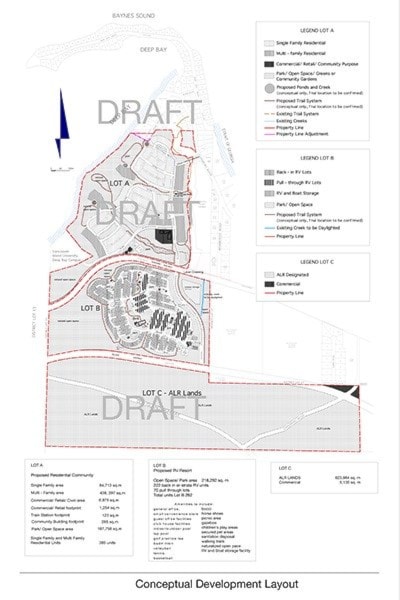Both sides in a debate over a proposed development in Deep Bay passionately cited the cause of democracy, but when it came time for a vote Tuesday night, Regional District of Nanaimo directors opted to move the proposal forward — in the name of democracy.
If approved, the controversial proposal by Baynes Sound Investments Ltd. would see 386 residential units, commercial buildings, a 292-unit RV resort, community building, sewage treatment centre and park and open spaces.
The Deep Bay Improvement District currently has roughly 1,200 residents, so the development would essentially more than double the population.
In order to proceed, proponent Jim Crawford would need the RDN to amend both the official community plan and the Regional Growth Strategy.
The proposal was strongly opposed in several delegations, including Dianne Eddy, who questioned Area H director Bill Veenhof's statement that he didn't know how the area residents felt about the project, submitting a survey of 187 area residents, of whom 168 expressed opposition to the plan.
"That's 97 per cent opposed," Eddy said. "Disregard this survey if you wish, but where is the survey provided to you to counter that?"
Eddy said the proposal would have profound impacts on Deep Bay itself, as well as other rural areas within the RDN.
"This development will zone current lot sizes from two hectares to a density of nine units per hectare — and half the development is unusable because of setbacks from beaches and creeks, so the density on the remaining land will be 18 units per hectare," she said. "This represents a pattern of urban sprawl applicable to any area in the RDN."
Resident Ian MacDonald also spoke against the project.
"I am against having a single developer force changes to the OCP and Regional Growth Strategy," he said.
Nelson Eddy noted that many area residents had not received information about the plan and were surprised when approached by people handing out the survey.
"The developer should have placed large ads in papers to sell their project to area residents and should have warned people that it might need the OCP and RGS modified," he said.
Crawford also took to the stand to defend his plan.
"This application was made public two years ago and received tremendous support from the community, as well as concerns, mostly about traffic and water supply," he said. "Some concerns were legitimate and some were misinterpretations."
Crawford said the next step — a public consultation process — would allow residents to get a deeper understanding of what he is proposing.
"It will be an opportunity to provide constructive feedback and will build from previous engagement activities," he said.
In moving to support a review of the application, Veenhof stressed he had heard many who were both for and against the plan.
"What I have to do is balance both elements and to do that we are going to go into full and formal public consultation," he said. "Then there will be a survey of affected area residents and that survey will fundamentally shape how I view the application."
He stressed that the vote was not tantamount to project approval, but rather, allowed for broad consultation about whether it should be approved.
"The public consultation essentially will determine what happens to the Baynes Sound application," he said. "When the survey is complete, we will vote on it."
Veenhof thanked Eddy for her survey and moved that it be included as the first item in any future consultation process.
The other directors agreed, voting to move the proposal on to the next phase.
